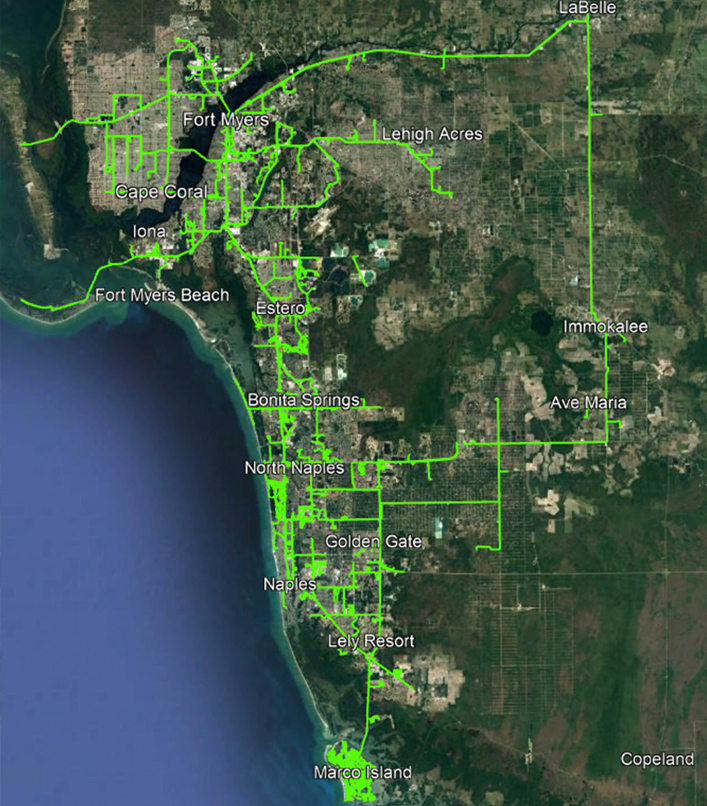Summit to Summit – Channel Partners Newsletter Vol. 3
September 3, 2023
Published by Ken Barrios, Director of Partner Channel, Summit Broadband
Welcome to Summit Broadband’s Summit to Summit Channel Partner Newsletter Volume #3. Here’s what’s inside this edition:
- Market Focus: Southwest Florida is Ready to do Business!
- Events: Summit Broadband Attending Channel Futures Leadership Summit 2023
- Editorial: The Future of Communication Channels – A Technical Journey into the Next 5 Years
- What Motivates the Buyer to Sign: Behavioral Neuroscience – We’re Only Human!

Market Focus: Southwest Florida is Ready to do Business!
Basking in the sunsets off the Gulf of Mexico, Southwest Florida is noted for its hometown agrarian communities, where the pace of life slows, and the charm of rural living harmonizes with the coastal beauty of the region. However, Southwest Florida is ready to do business.
Fort Myers, Cape Coral, Bonita Springs, Naples, and Marco Island, are driven by a diverse set of economic factors that contribute to its overall economic stability and growth. Some of the key economic drivers in this region include the following market segments.

- Tourism and Hospitality: Southwest Florida is a major tourist destination, known for its beautiful beaches, golf courses, and cultural attractions. Tourism and hospitality industries, including hotels, restaurants, and entertainment venues, play a significant role in the local economy. The region experiences a seasonal influx of snowbirds and vacationers, particularly during the winter months.
- Healthcare and Retirement Communities: The region has a large population of retirees, which has led to the growth of healthcare services and retirement communities. The healthcare sector, including hospitals, clinics, and medical research facilities, is a significant contributor to the local economy.
- Real Estate and Construction: The real estate market in Southwest Florida has historically been a major driver of economic activity. With a growing population and demand for residential and commercial properties, the construction sector is also vibrant. Real estate development, both residential and commercial, is a key driver of job creation and economic growth.
Summit Broadband has been a major participant in the growth of the region for decades who are well known to the community for its local service and responsiveness with dependable services. As a result, Southwest Florida presents a compelling opportunity for technology advisors looking to make an impact. With a vibrant local business community poised for growth, the region is primed for business development.
As a leading player in the area, Summit Broadband is ideally positioned to serve the SMB to Mid-Market segment with a comprehensive suite of products and services tailored to meet their everyday needs.
As highlighted in our previous communications, Summit Broadband operates a robust channel harmony program, fostering a collaborative environment where our direct team seamlessly collaborates with channel partners. This synergy not only streamlines operations but also translates into a stronger ability to close sales. If you’re a technology advisor seeking a dynamic partnership in an emerging market, Southwest Florida should be on your radar.
Events: Ken Barrios to Attend Channel Futures Leadership Summit 2023

We’re excited to announce that Ken Barrios, a prominent figure at Summit Broadband, will be attending the highly anticipated Channel Futures Leadership Summit scheduled from October 30th to November 2nd, 2023. This event promises to bring together some of the brightest minds in the technology and business sectors, making it a prime opportunity for networking, learning, and collaboration.
Ken Barrios is a well-respected professional known for his extensive contributions in the telecommunications and technology space. With a proven track record of fostering innovation and growth, he plays a pivotal role at Summit Broadband, a leading player in providing cutting-edge solutions to businesses and consumers.
As an attendee of the Channel Futures Leadership Summit, Ken Barrios will have the chance to interact with fellow thought leaders, industry experts, and technology advisors. This event offers a platform for sharing insights, discussing trends, and exploring collaborative opportunities that can shape the future of the technology landscape.
One of the key areas Ken Barrios is eager to delve into is how Summit Broadbands’ services can positively impact the bottom line of technology advisors. With a strong commitment to innovation, quality, and customer satisfaction, Summit Broadband is poised to offer valuable solutions that align with the evolving needs of businesses. Ken Barrios aims to explore these synergies and foster meaningful connections that can drive mutual growth.
Connecting with Ken Barrios
If you’re attending the Channel Futures Leadership Summit, this is a unique chance to connect with Ken Barrios. His insights and expertise in the technology sector, coupled with Summit Broadband’s offerings, could lead to exciting prospects for collaboration and advancement. Click Here to Schedule a Meeting with Ken Barrios.
Editorial: The Future of Communication Channels – A Technical Journey into the Next 5 Years.
Certainly, the indirect channel will play a significant role in shaping the development of communication channels over the next five years. Indirect channels refer to intermediaries that facilitate the distribution of products, services, or information between producers/providers and end-users. In the context of communication, indirect channels can influence the adoption and evolution of new communication technologies. Predicting the future with absolute certainty is challenging, but we can make informed projections about the potential evolution of communication channels over the next five years based on current trends and emerging technologies. Here’s a speculative glimpse into what the future of communication channels might hold for the Trusted Partner’s clients:
- Augmented Reality (AR) and Virtual Reality (VR) Communication: Over the next five years, AR and VR technologies are likely to play a significant role in shaping communication channels. Virtual meetings and social interactions could become more immersive and lifelike, allowing people to feel like they’re in the same physical space even when they’re miles apart. AR glasses or contact lenses might enable real-time overlays of digital information onto the physical world, enhancing communication.
- Holographic Communication: Holographic displays and projections could become more accessible and mainstream, allowing individuals to communicate with their lifelike holographic avatars. This technology might revolutionize business meetings, remote collaboration, and even personal interactions.
- 5G and Beyond: The rollout of 5G networks will likely continue, offering ultra-fast and low-latency communication. This could facilitate real-time high-definition video conferencing, smoother virtual reality experiences, and seamless IoT device communication. Beyond 5G, research into 6G and other advanced wireless technologies could already be underway.
- AI-Powered Communication Tools: Artificial intelligence and machine learning will continue to enhance communication tools. Chatbots and virtual assistants will become even more sophisticated, providing instant and contextually relevant responses across various platforms. Language translation tools will likely improve as well, enabling smoother global communication.
- Biometric Authentication: Communication security might increasingly rely on biometric authentication, such as facial recognition, fingerprint scans, and even voice analysis. This would enhance data privacy and reduce the risk of unauthorized access to communication channels.
- Neuro-Interface Communication: While still in the realm of speculative technology, there might be progress toward developing direct communication interfaces between the human brain and digital devices. This could potentially revolutionize communication for individuals with disabilities and lead to entirely new ways of sharing thoughts and ideas.
- Integration of IoT and Communication: The integration of the Internet of Things (IoT) with communication channels could lead to more connected and context-aware interactions. Smart devices could anticipate our needs and preferences, facilitating seamless communication between humans and technology.
- Decentralized and Blockchain-Based Communication: Blockchain technology could be used to create more secure and private communication networks, with decentralized control over data and interactions. This might address growing concerns about data breaches and centralized control of communication platforms.
- Environmental Considerations: The next five years could strongly emphasize environmentally sustainable communication technologies. Companies might develop more energy-efficient data centers, and virtual meetings could contribute to reduced travel and carbon emissions.
- Hybrid Work Environments: The COVID-19 pandemic has accelerated the adoption of remote work. Over the next five years, a hybrid model of work might become the norm, requiring communication tools that seamlessly bridge the gap between in-person and remote interactions.
Remember, these projections are based on current trends and emerging technologies, and the future could hold surprises we can’t anticipate. As technologies evolve, so will the ways we communicate, connect, and collaborate.
What Motivates the Buyer to Sign? Behavioral Neuroscience – We’re Only Human!
From the perspective of behavioral neuroscience, the motivations behind purchasing telecommunications services can be understood in terms of brain processes and psychological factors. Here are three major factors:
- Reward and Pleasure Systems: The brain’s reward system, primarily involving the release of dopamine, plays a significant role in motivating purchasing behavior. Telecommunications services, especially those tied to entertainment and social interaction, activate this system. For example, the anticipation of using high-speed internet for streaming, online gaming, or accessing engaging content can trigger feelings of pleasure and excitement, which can drive individuals to make a purchase.
- Social Connection and Oxytocin: Telecommunications services are often deeply linked to social interactions. Human brains are wired to seek social connections and belonging, driven by the hormone oxytocin. The ability to stay connected with friends, family, and colleagues through telecom services activates the brain’s social circuits, generating positive emotions and reducing feelings of isolation. The purchase of these services can be motivated by the brain’s natural inclination to foster social bonds.
- Novelty and Curiosity: The brain is highly responsive to novelty and curiosity. Telecommunications services often introduce new features, technologies, and content that tap into this aspect of brain function. The allure of experiencing something new and exciting can stimulate the brain’s exploration and learning systems. For instance, the introduction of cutting-edge smartphones or innovative communication tools can trigger a sense of curiosity that drives individuals to explore and ultimately make a purchase.
It’s important to note that these factors are interconnected and can vary based on individual differences. The brain’s response to purchasing telecommunications services is influenced by a complex interplay of emotions, cognitive processes, and neural circuitry. Behavioral neuroscience helps us understand why certain features and benefits of these services appeal to our brain’s fundamental mechanisms, driving our purchasing decisions.
To learn more about Summit Broadband Channel Partners, contact Ken Barrios:
Email: summitpartnerinfo@summitbb.com / Phone: 407.961.1960